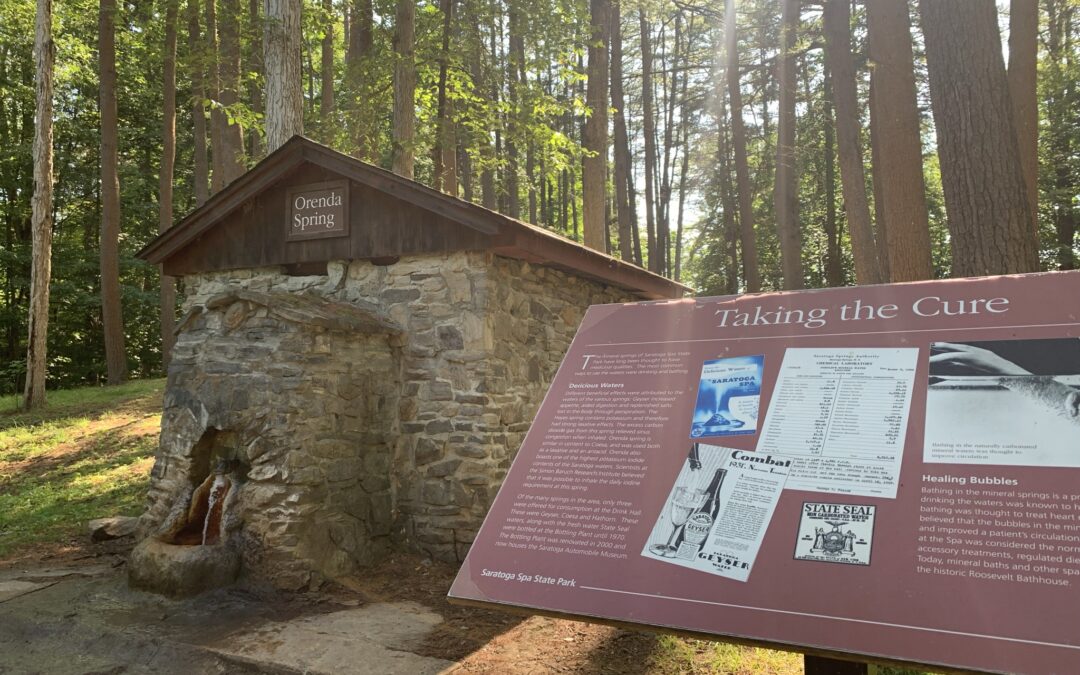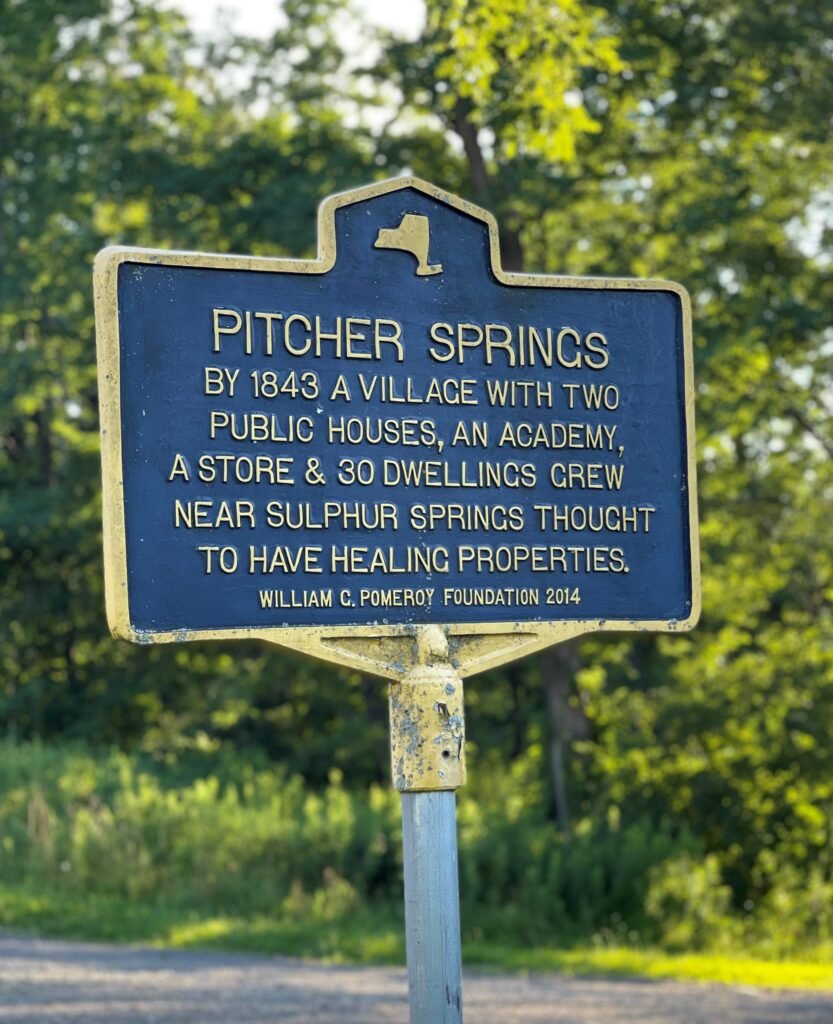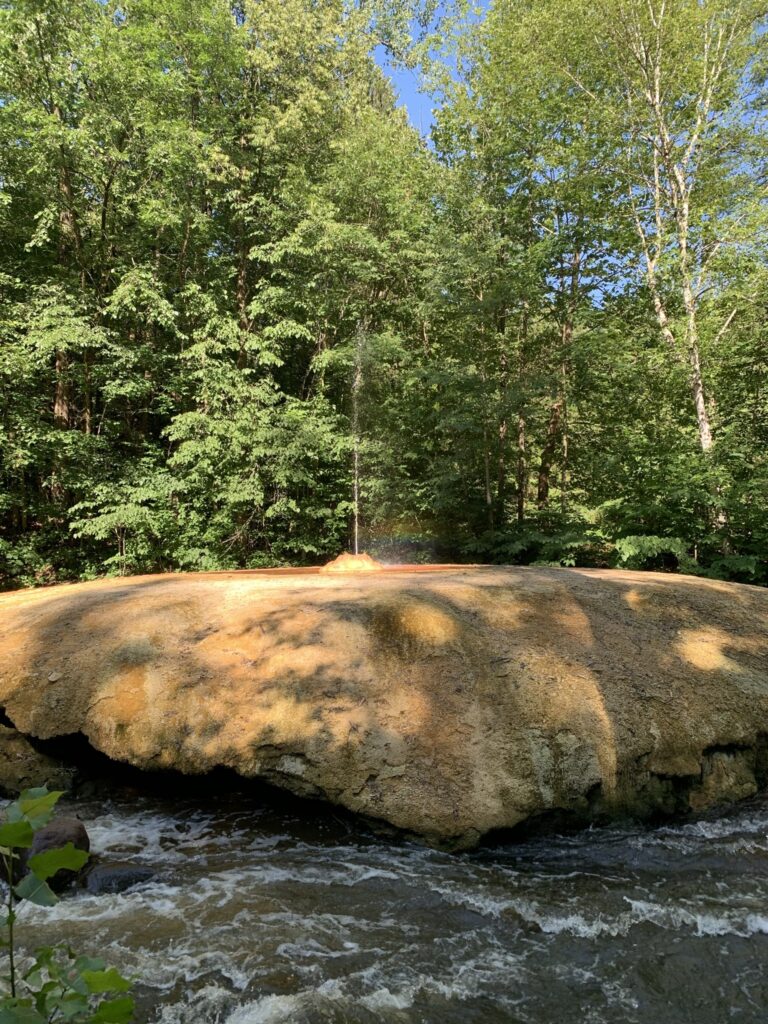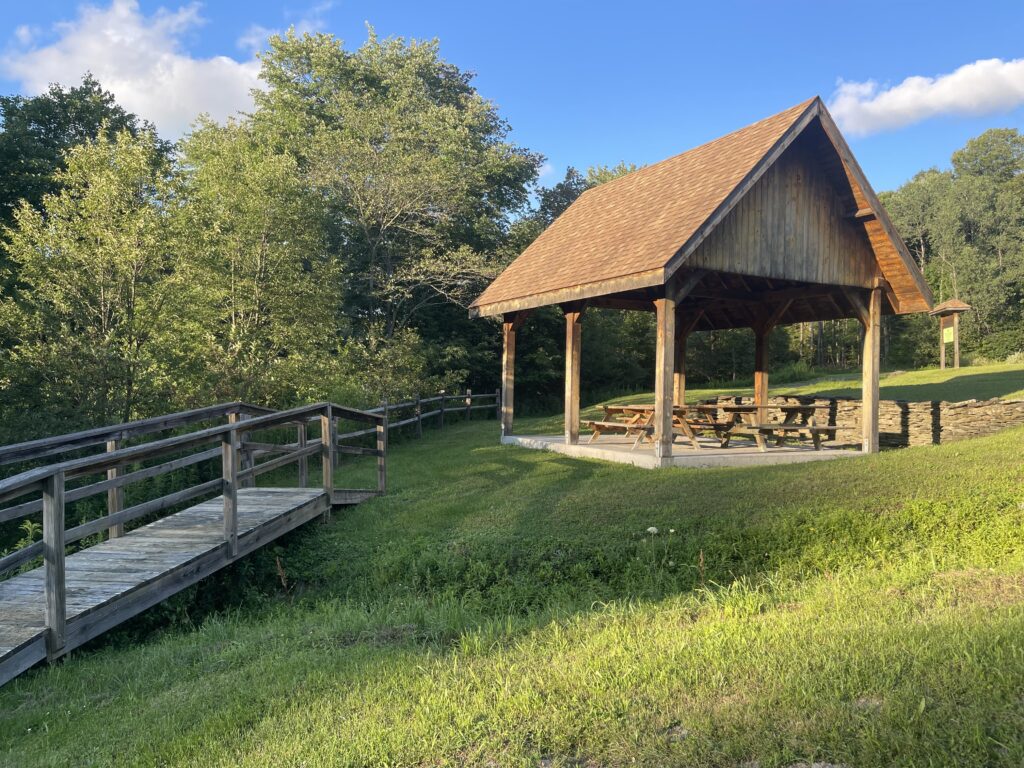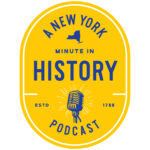
This episode delves into the public health industry that emerged in New York in the 19th Century. As the understanding of medicine and health evolved over time, there were many communities in New York state whose location was thought to have healing properties, most often because of the existence of springs or some other perceived environmental benefit. The most famous is Saratoga Springs, but there are others around the state, including Pitcher Springs in Chenango County. These locations flourished in the 19th Century, as people began to look to them not only as places of healing, but as places of high society and entertainment.
Marker: Pitcher Springs, Pitcher, Chenango County, NY
Guests: Pitcher Town Clerk Emily Stith; Canisius College Professor Thomas Chambers, author of Drinking the Waters: Creating an American Leisure Class at Nineteenth-Century Mineral Springs
A New York Minute In History is a production of the New York State Museum, WAMC, and Archivist Media, with support from the William G. Pomeroy Foundation. This episode was produced by Jesse King. Our theme is “Begrudge” by Darby.
Further Reading:
- American Physicians in the Nineteenth Century: From Sects to Science, William G. Rothstein (1992)
- Sickness and Health in America: Readings in the History of Medicine and Public Health, edited by Judith W. Leavitt and Ronald L. Numbers (1997)
- A History of American Medicine from the Colonial Period to the Early Twentieth Century, Luis H. Toledo-Pereyra (2006)
Teaching Resources:
“A Guide to History of Medicine Resources: Image Collections, Podcasts, Videos, and More,” Association of College and Research Libraries.
Resources, American Association for the History of Medicine.
Follow Along
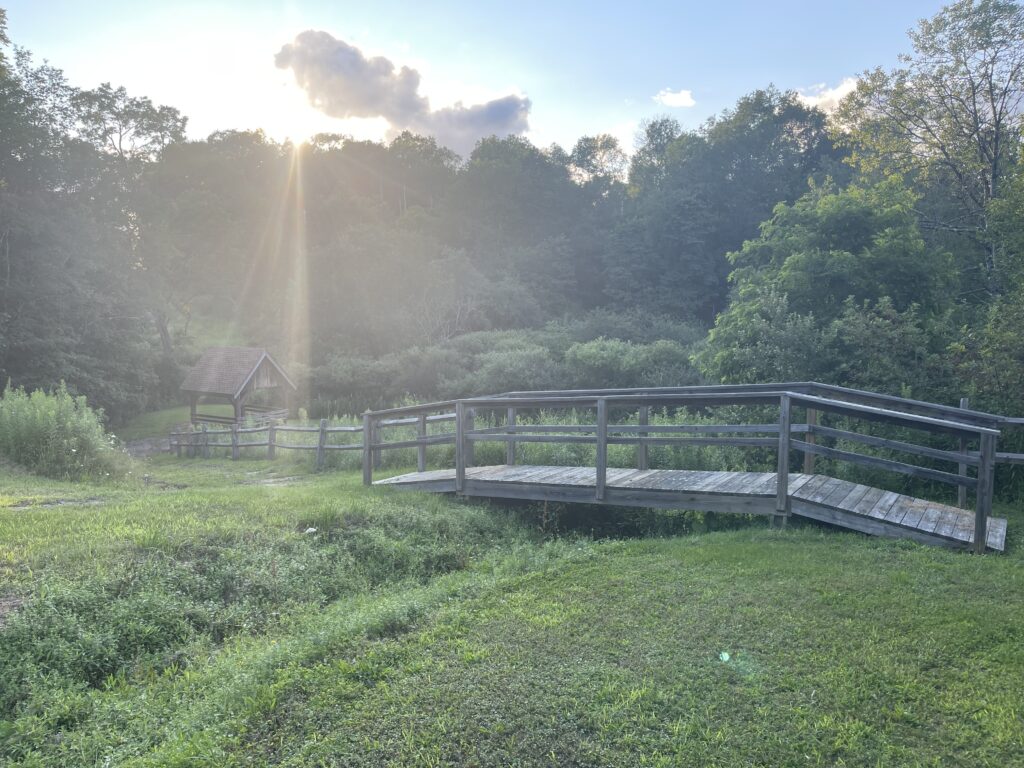
Devin: Welcome to A New York Minute In History. I’m Devin Lander, the New York state historian.
Lauren: And I’m Lauren Roberts, the historian for Saratoga County. On this episode, we’re going to be talking about the water cure, and its popularity in New York state in the 19th Century. Now, being the Saratoga County historian, I’m quite familiar with the popularity of the mineral springs in both Saratoga Springs and Ballston Spa, in my county. But today, the marker we’re going to be focusing on is actually found in central New York. Located in Chenango County, in the town of Pitcher, is a marker titled “Pitcher Springs.”
And the text reads: “By 1843, a village with two public houses, an academy, a store and 30 dwellings grew near sulphur springs, thought to have healing properties. William G. Pomeroy Foundation, 2013.”
This is what we know about Pitcher Springs. It was a small hamlet situated in the town of Pitcher that boasted two or three sulphur springs, and it became a popular area for tourists to come and take in these waters in the hopes that it would heal whatever their ailments were. I spoke with the current Pitcher Town Clerk Emily Stith, who has a personal connection to the town’s history.
Emily: We currently don’t have a historian, the previous historian was my grandmother, Rita Stith, and no one has filled that role since her passing.
Lauren: Emily’s grandmother was the one who applied for the Pomeroy marker back in 2013.
Emily: This is definitely a labor of love for her…Settlers in this area kind of gravitated towards the hillside farms. It was difficult to find water that was pure, because anything in the river valleys, there was a lot of marsh land. I did find one story, where there was a young man named Denison Hakes, who just happened to be walking one day from his father’s hillside farm that wasn’t far from the springs. And he actually was able to drink from the water.
They actually erected several boarding houses, there were hotels and an academy was built. They had a bowling alley, there was a tavern. The Eagle House was a grand hotel then. They believed that it was built from wealthy investors that came from New York City or Philadelphia or Albany or California, but they pretty much relied on the consumption in bathing in the springs. I found reference to what they refer to as “rose cancer” at the time, which I can only surmise to be what we would call rosacea now, that people utilized to address that. I also found reference to a story of a young boy whose name was Willy Harrington, and he had come down with typhoid fever. And they found it in family diaries, where he attributes his survival to going to the springs and actually drinking the water.
Lauren: One of the advertisements for the Eagle House says: “The proprietor is now, and has been for the past six months, successfully treating diseases in all its forms hydropathically, ethically, at his house. To say that he has had none under his care for any length of time, but what have been benefited by the water treatments at his establishment located at Pitcher Springs.
Pitcher Springs experienced its heyday in the 1830s and 40s. But according to the history of Chenango County by James H. Smith, published in 1880, it was short lived. By the time Smith was writing his book, only two buildings remained, and it had long since gone dormant as a tourist attraction. There’s no doubt the hamlet’s popularity was a result of its mineral springs. So what made people turn to spring water as a type of medicine in the first place?
Devin: Well the idea wasn’t totally new – baths and springs certainly had popularity in Europe, and people in many rural areas, without easy access to physicians, were often self medicating, and using things like botanical remedies that may have been passed down from generation to generation. And certainly the Native Americans had their own traditional healing methods, some of which may have included springs.
But we also have to remember what people’s “official” medical options were at the time. What we know from researching this topic is that during the colonial era and throughout the early-to-mid 19th Century, America was a particularly unhealthy country – at least when you compare it to Europe. Established physicians, those who called themselves doctors, received poor training that was based heavily on medical practices that dated back to ancient Greece. This was called heroic medicine, and was a belief that the body had to be shocked back to health as a result of diseases that affected the “humors,” otherwise known as your blood, yellow bile, black bile and phlegm.
This is what they believe, these were the doctors who were actually trained. Some of these doctors were trained at medical schools, mostly during the 19th Century, these would have existed in Europe, although there were a few in the United States, including Colombia – but other physicians were trained by being apprentices to a physician. And sometimes this lasted as little as one year.
Now, we have to remember, too, that at this time, surgery and surgeons were different than physicians. They may have had more knowledge about anatomy, but very little knowledge about how to manage pain. Oddly, most surgeons up to the Civil War era were also barbers.
Lauren: What?
Devin: It was believed that if you could handle a surgeon’s knife, you could also handle a pair of shears.
Lauren: That’s a comforting thought.
Devin: During the 19th Century, there are three basic ways that physicians would treat an ailment. Number one: bloodletting, which was draining a patient’s blood, and was used for various fevers that were rampant during the era as a result of outbreaks of cholera, yellow fever, malaria, etc. Frequently, this process was done so often to a patient, that death would result.
For example, in 1799, President George Washington was diagnosed by one of his physicians as having an inflammatory affection of the upper part of the windpipe, which led to a fever and laborious respiration. The report stated: “The necessity of bloodletting suggesting itself to the general, he procured a bleeder in the neighborhood, who took from the arm in the night 12 or 14 ounces of blood. The following day, discovering the case to be highly alarming, and foreseeing the fatal tendency of the disease, two consulting physicians were immediately sent for, and in the interim were employed two copious bleeders. A blister was applied to the part affected. Two moderate doses of calomel were given, and an injection was administered which operated on the lower intestines – but all without any perceptible advantage.
Upon the arrival of the first of the consulting physicians, it was agreed to try the result of another bleeding. About 32 ounces were drawn, without the smallest apparent alleviation of the disease. 10 grains of calomel were given, succeeded by repeated doses of emetic tartar, amounting to five or six grains. The powers of life seem now manifestly yielding to the force of the disorder, blisters were applied to the extremities, together with a cataplasm of Bran and vinegar to the throat. Speaking, which was painful from the beginning, now became almost impractical. Respiration grew more and more contracted and imperfect, till he expired without a struggle.”
Lauren: That’s terrifying.
Devin: Sounds like medieval torture. And this was George Washington, first president.
Lauren: So you would think he would be able to afford the best medical treatment of the time.
Devin: These were the most famous physicians that he could call for. They were students of Benjamin Rush, who was at the time the most famous physician in North America, and he was a major proponent of bloodletting, and also was confused by how much blood the human body actually held. He believed it held two times as much blood as it actually did.
Lauren: Devin, you also mentioned, besides the bloodletting, that they were blistering him. What does that mean?
Devin: Yeah, there’s a couple other things, he ran the whole gamut. Blistering was basically when a blister was raised on a part of the body that was ill and then broken, and the discharge from the broken blister was thought to include whatever toxins were affecting the ill person. Of course, none of this had any reality in science or medicine as we know it. But these were the types of treatments that your average person, when they would go to a physician, this is what they would get. Emetics and purgatives were kind of the third thing that physicians had at the time. Purgatives were more common, and the most common of these was called calomel, which was mentioned in the Washington account, and also happened to contain mercury – which as we know, is highly toxic and can cause deaths
Lauren: It begs the question, why would physicians use these treatments if they either didn’t work or caused the death of their patients?
Devin: Physicians used these treatments because they did something. A physician couldn’t just say, well, there’s nothing I can do for you, just go home and ride it out, get better or die. That’s not something that a physician could say and hope to have repeat business.
Lauren: Alright, so if I lived in the early 1800s, and I had a health issue, and my choices were bloodletting, blistering and purgatives – or, I could try this newly popular water cure, I think it would be pretty easy to choose which direction I would go in.
Devin: And it’s something that I talked about with Thomas Chambers, a professor of history at Canisius College, who wrote the book Drinking the Waters: Creating an American Leisure Class at 19th Century Mineral Springs. One of the concepts that we talked about was the democratization of American medicine.
Thomas: People started to see that maybe they could take a greater role in their own health. A lot of physicians began to prescribe a variety of different cures, and even being able to scientifically say, “this water has this mineral composition, therefore it helps with these ailments.” And everything from dyspepsia, to cancer, to infertility – each spring was claimed to have a specific curative power over that particular ailment. Whether or not there’s any actual efficacy to that, I’m not a physician. But the promoters at the time certainly said it, and many people would include testimonials, where they went to the springs, they drank the water, and it cured what was wrong with them.
So they could go to Saratoga or Richfield Springs or wherever and be able to think that they were taking charge of their own cure. They were doing something that had a visible effect. In a more general sense, though, it just was going out, in some cases, to a more rural place with fresh air. A little exercise, people would like to walk and ride. [Eating] maybe a slightly better diet, and certainly [drinking] something that, if it has no other effect, even today, a lot of these springs at least have the effect of calming your stomach. And they can also be diuretics.
Devin: So they were turning away from these invasive, terrible, and sometimes deadly medicine prescribed for them by physicians, and towards healing springs, botanical treatments, homeopathy, and nontraditional diets, such as Sylvester Graham’s vegetarianism, and his belief in eating whole grain, which led to a popular movement that gave us the graham cracker. Or as our own Dr. James Henry Salsbury, an early proponent of both the germ theory and the Paleo diet, who gave us the salsbury steak, which he recommended be eaten three times a day with strong coffee to relieve diarrhea.
Lauren: Changing the diet, which is of course, something we still use today, became a very popular way that you could also control your health. Some of the things that were served at sanitariums, both in Pitcher Springs and Saratoga Springs, were graham crackers and graham pudding.
Depending on what your health issue was, you may be prescribed to drink from different springs with different mineral properties. Or you may apply the mineral springs to your skin in different places. If you had rheumatism, if you had a wound, you might soak that extremity in the spring water and then wrap bandages around it. People would soak in mineral baths, some would be doused in cold mineral water – for some reason they felt that the colder it was, the more effective it was. Or at least so it seems, by the accounts of people who were writing about taking the water care during that time.
There was a cost when you wanted to go and stay at one of these sanitariums, but just to drink the water, they were seen as public. I know in Saratoga Springs and Ballston Spa, it was important, especially to the local citizens, that the people who were coming to take the water could get the water for free. You may have tipped a dipper boy or somebody who was actually reaching into the spring to take the water out for you, but if you could pay to get yourself transportation to one of these places, then the water itself was to be enjoyed by everyone. That’s an important part of also taking back some control, because medicine was expensive, and a lot of people did not have the means to pay for individual treatments by these physicians.
Devin: OK, so we know what’s attracting people to these springs. But how are some of these resorts built, like Ballston Spa and Saratoga Springs?
Lauren: Their locations really lent themselves to ease of transportation for visitors far and wide. One of those main routes was the Hudson River, it was navigable up to Albany. And then after they got off their boat, they could take a stagecoach up to Saratoga, which wasn’t terrible. One of the earliest railroads was one that went from Albany to first Ballston Spa, and then, the following year, Saratoga Springs. There was a railroad to get to Saratoga Springs in 1833, so that’s very early for railroads.
And then once you bring them there, you need to provide accommodations for them. And then also other things to do to fill the time. So in addition to building large hotels, and sanitariums, and things like that, there was also the desire to provide entertainment for the guests while they were staying there. Early on, guests didn’t stay more than a week, usually. And then as time went on, the proprietors of the hotels wanted them to stay longer and longer. So they thought of more things for them to do during the summer months.
Ballston Spa was popular as a destination for the healing waters prior to Saratoga Springs. And they had the Sans Souci Hotel, which was a world-renowned hotel that could hold a lot of visitors. But once Gideon Putnam starts going in Saratoga Springs, he’s really seen as kind of the father of the city. He was responsible for laying out the streets, and he made accommodations for things like a school and church and a burying ground, and really set up the village of Saratoga Springs.
And that’s when we get into the Victorian era, and the popularity of Saratoga Springs for the wealthy. Now they’re coming and staying for the entire summer season. We have the development of the race track, we have the high fashion scene in Saratoga.
Devin: We’re really talking about the tourism industry kind of being born. And it’s something that we spoke with Thomas Chambers about.
Thomas: It happened, I think, because we got to the point where in the United States, there were people with leisure time. They had money, they had the ability not to have to work all the time, and with that, they wanted to both do something to pass the time – but also to display their wealth and their newfound status. Where do they go to do that? You know, leisure at this point in time still had to be somehow productive. So you couldn’t go to an amusement park. That was too profligate. But if you went to a health resort, well, then you were doing something good for yourself. And that was acceptable leisure in American culture at the time.
Especially as cities became more crowded and more unhealthy in the summer months, people would want to escape and go somewhere where they could either, in the south, get to the mountain air – certainly that’s the same idea to get into Saratoga, especially for Manhattan, is that you went to a healthier climate. And when you went to that healthier climate, you also wanted to be there with people who were of your similar social ilk. They’re from all over the country. You know, Saratoga is a national resort. And there they were able to meet, in some cases, politicians, businessmen. There’s certainly courtship that happens there. It’s a place to see and be seen in in the emerging market economy. People want to be able to display their wealth. Those summer resorts are one of the best ways that that can be done.
Devin (to Thomas): You also note that the springs, in specifically Virginia and New York, “functioned as a laboratory for the new nation, and a site of unification during the late 19th Century.” So this is post Civil War era. Can you explain this? Because this is a fascinating concept.
Thomas: You know, one of the interesting things is that, after the Civil War, there needs to be some sense of bringing the country back together. One way to do that was for those elites that had, in some cases, born arms against each other, to find ways that they could create some sort of new national identity, or new national unity. Again, leisure’s an easy way to do that. And if you can find resorts where people from north and south can gather together and exercise their social status, well, maybe then they’re worried about something other than the extension of slavery, or the preservation of states rights, depending on which part of the United States you’re from.
Devin (to Thomas): How successful really was that though? It seems that certainly would be successful with the very elite classes. But these resorts were really not accessible to great swathes of the nation.
Thomas: We have two categories of springs, if you will: national resorts and then local ones. Almost every county in the United States, at some point time, had some sort of a springs. You know, you look at place times on maps and springs pop up everywhere. There’s something like over 70 towns in America called Saratoga, really trying to imitate that early success. And so small towns would have a proprietor build a hotel, declare that the water was healthy, and attract people. And so maybe you weren’t one of the wealthy national elites, but you know, you’re a successful merchant in your town. Well, you went to that springs resort, that was your way of finding some sense of local or regional authority.
For most people, it was the local place that they went to, and the prevalence of them across the country really, I think, shows that springs resorts were an everyday part of 19th Century America. At least while the water was still running.
Devin (to Thomas): Saratoga is still a major destination. The springs are heavily visited every time I go there, there’s people drinking from the water. Is there a set of reasons, or a reason, that the spring movement kind of wanes?
Thomas: It was a number of different factors. Something as simple as people started to realize that maybe the spring water didn’t cure the diseases that it claimed, and so that sort of fell out of favor. People’s ability to travel changed as well. With the evolution of railroad travel, people were able to go farther faster. In Saratoga Springs, the horse track is much more exciting, and gambling is much more exciting, by the latter half of the 19th Century. People’s tastes and interests changed. Right now, you could probably point to any number of different kinds of hospitality and tourism trends that come and go. Last summer during the coronavirus pandemic, people wanted to go into the countryside, and so camping had a resurgence at that point in time, just because that was what was of most interest to people. Then, as people were able to travel more, mineral springs resorts fell out of fashion to a significant degree.
Devin: So as we see the leisure industry and the tourism industry really become created around these springs, what does this all mean for the medical establishment that we were talking about before? Many of these alternative practices open the doors to unscrupulous medical practitioners who advocated a variety of false medicines, which became known as snake oil.
Now, most of us know about the Civil War, and how many soldiers on both sides died on the field of battle. But we may not be aware that many more died from disease. One way to look at the Civil War was as a laboratory for American medicine. For physicians and surgeons, the Civil War provided a terrible but real opportunity to use things like anesthesia, to learn how to better perform amputations, and take care of operations of the vascular system and things like catastrophic injuries that they otherwise may not have come across. And despite its inability to handle most of the cases, the field itself did learn from that terrible tragedy of the Civil War.
I think you have a medical field that realized it was behind the times, that there needed to be more medical schools, there needed to be licensing of physicians and surgeons, that this needed to be looked at as a science – which is something that American physicians had denied for a long time. In a way, it was the turn away from established medicine and the creation of alternative forms of medicine, along with the Civil War, that kind of woke the American medical establishment up and helped them become more scientific, and start to believe in things like the germ theory, and understanding how all of that works.
So Lauren, you mentioned in the 1880 history of Chenango County, that by 1880, Pitcher Springs is really nonexistent. Can you tell us a little bit why that might have happened? And how different that is from Saratoga Springs, which is still thriving today?
Lauren: Part of the reason that Saratoga remained popular was one, because of location. Two, we had the bottling of the water. That became such a lucrative part of being able to make money on the springs – because of course, we’re talking about New York. New York’s got, what, four months of good weather? And then what happens? So you didn’t even need to come to Saratoga anymore. But the people who had the rights to bottle the water at the different springs were still able to make a profit, so that way they could keep those hotels or sanatoriums or areas of entertainment open during the good months. They had a sustaining income in the winter.
The ultimate blow according to Emily, is what you were talking about, Devin. After the Civil War, medicine got better, and the springs movement went into a decline.
Emily: Additionally, part of the reason [Pitcher Springs became] like a ghost town was that it was so difficult to get materials, that a lot of the houses that were raised, they took them down, and they built things later. If you don’t know what happened to Pitcher Springs, I can tell you Pitcher Springs built half Pitcher, because they moved the materials to build other homes. And actually, the Eagle House was taken down, and part of that lumber was taken to Norwich to build another building in Norwich.
The Civil War happened, a lot of fortunes were lost. I even found reference to the gold rush in California, where they said that as many as 200 people from the Pitcher and Pharsalia area left to join the gold rush, to go to California.
I’m just really honored that you reached out to us for this particular thing, because I have to tell you, my grandmother would just be over the moon. For years actually, an area of the springs there was just like an old dilapidated house, you might even miss it. You wouldn’t even know it was there. And with the effort of getting the historical marker, the town actually erected a park. So now there’s a pavilion. There’s some picnic tables, it’s mowed. People could have a party there if they wanted to. And there’s still a house over the spring. It is still in existence, it hasn’t dried up. It is something that visitors could come see and spend some time with, if they like.
Lauren: You’ve been listening to A New York Minute In History. This podcast is a production of WAMC, the New York State Museum, and Archivist Media, with support from the William G. Pomeroy Foundation.
Devin: Our producer is Jesse King. If you like what you’re hearing, check us out on Twitter and Instagram at @nyhistoryminute, or give us a listen at wamcpodcasts.org.
Lauren: Until then, I’m Lauren Roberts.
Devin: And I’m Devin Lander.
Excelsior.
